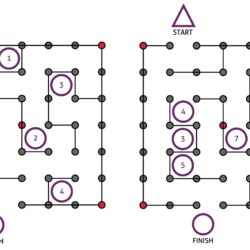Today’s event was a chance to work on skills that can help us improve as orienteers. Bob Boltz set a course targeted at two skills. Read more…


Today’s event was a chance to work on skills that can help us improve as orienteers. Bob Boltz set a course targeted at two skills. Read more…

Practice your O-skills even when you’re not out in the woods! The Maze-O will challenge your brain, and sense of direction while finding the shortest, or the fastest routes through the mazes. Each turn slows you down, so try for a straighter line through, with the least amount of turns. And who knows, maybe you’ll see something like this in the near future…

Andreas Johansson, member at Northeast Ohio Orienteering Club (NEOOC), introduces orienteering with some of the basic stuff you might encounter at your first event.

This is a description of the standard orienteering course levels and the skills required to do each one — ordered from easiest to hardest. This list is to help you decide which orienteering course and/or which training session to select. Above all, remember that orienteering is intended to be fun. Choose the course which challenges your current skill level but is still easy enough to be fun for you.

Have you wondered what all those little clue symbols mean? Or need to brush up from last season? Here’s an easy to use control description 1-pager, used with permission from, and developed by Mike Minium of OCIN.

Andreas Johansson from NEOOC describes how to overlay your GPS track (from a Garmin device) on a map, and how to adjust the track.

We were just getting started with 30 pre-registered scouts, when 12 more showed up to learn about orienteering! A few more tables and chairs later, and we were all learning about the basics of orienteering. Some of the requirements for the Boy Scout Merit Badge for orienteering were covered, and scouts practiced taking compass bearings, taking their pace count, and about land forms, orienteering map features, and some of the basic techniques an orienteer uses while on a course. Click to read more…

Using handrails is an easy way to get from one control to the next. A handrail is a feature you can easily follow out in the woods, like a trail, water feature, distinct contour line (like running along a ridge line), or something similar. In the example below, the trail acts as the handrail from control 1 to control 2.